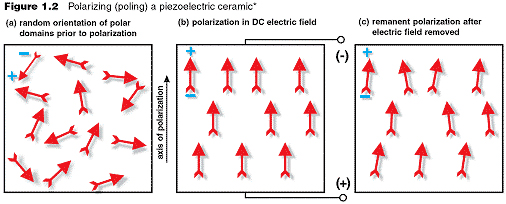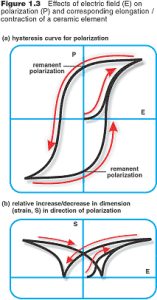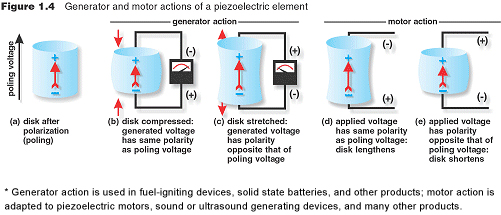Jump To: How Does Piezoelectricity Work? | Piezo Sensor Applications | Ceramic Elements | Contact Us
The term “piezoelectricity” has its roots in the Greek words for “press” and “amber” — which historically has been used as a source of electricity. Literally translated, “piezoelectricity” refers to electricity that’s the result of the application of latent heat and pressure.
Due to the application of mechanical stresses, an electric charge can build up in a number of solid materials, including select ceramics, crystal materials, and some biological materials like DNA, bone, and certain proteins. The resulting effect is a type of electricity produced because of pressure and/or latent heat — otherwise known as piezoelectricity.

What’s key to understand is that the energy applied to a material can be a knock, squeeze, tap or other force that impacts the material but doesn’t fracture it. As such, the force needs to be applied with the utmost care. Due to the force that’s applied, the material’s charge balance changes. For example, when a crystal’s charge balance is impacted by 10 percent, it generates electricity. Consequently, it will have a negative charge on one face and a positive charge on the opposing face.
Subsequently, the vice versa of this relationship was confirmed: if one of these voltage-generating crystals was exposed to an electric field it lengthened or shortened according to the polarity of the field, and in proportion to the strength of the field. These behaviors were labeled the piezoelectric effect and the inverse piezoelectric effect, respectively, from the Greek word piezein, meaning to press or squeeze.
Although the magnitudes of piezoelectric voltages, movements, or forces are small, and often require amplification (a typical disc of piezoelectric ceramic will increase or decrease in thickness by only a small fraction of a millimeter, for example) piezoelectric materials have been adapted to an impressive range of applications. The piezoelectric effect is used in pressure sensors, sensor applications, and nondestructive testing, such as in force or displacement sensors.
Piezoelectricity can be used for a range of piezoelectric applications such as inkjet printing and the detection and production of sound. For example, it’s used in smart phones to transform the energy of a person’s voice into electrical signals that are received by another phone and transformed into recognizable sounds. Piezo technologies are also used for the generation of electronic frequency, high voltage generation, the ultrafine concentrating of optical assemblies, driving ultrasonic nozzles and microbalances.
Because piezo technologies can be used for so many applications, it’s widely used across all industries and sectors. In addition to smart phones and devices, it also drives keyless entry devices, audible alarms such as smoke alarms, patient monitors, airbag sensors and fish and depth finders, to name just a few.
The inverse piezoelectric effect is used in actuation applications, such as in motors and devices that precisely control positioning, and in generating sonic and ultrasonic signals. In the 20th century metal oxide-based piezoelectric ceramics and other man-made materials enabled designers to employ the piezoelectric effect and the inverse piezoelectric effect in many new applications. These piezoelectric materials generally are physically strong and chemically inert, and they are relatively inexpensive to manufacture. The composition, shape, and dimensions of a piezo ceramic element can be tailored to meet the requirements of a specific purpose. Ceramics manufactured from formulations of lead zirconate / lead titanate exhibit greater sensitivity and higher operating temperatures, relative to ceramics of other compositions, and “PZT” materials currently are the most widely used piezoelectric ceramics.
A traditional piezoelectric ceramic is a mass of perovskite ceramic crystals, each consisting of a small, tetravalent metal ion, usually titanium or zirconium, in a lattice of larger, divalent metal ions, usually lead or barium, and O2- ions (Figure 1.1). Under conditions that confer tetragonal or rhombohedral symmetry on the crystals, each crystal has a dipole moment (Figure 1.1b).
To prepare a piezoelectric ceramic, fine PZT powders of the component metal oxides are mixed in specific proportions, then heated to form a uniform powder. The piezo powder is mixed with an organic binder and is formed into structural elements having the desired shape (discs, rods, plates, etc.). The elements are fired according to a specific time and temperature program, during which the piezo powder particles sinter and the material attains a dense crystalline structure. The elements are cooled, then shaped or trimmed to specifications, and electrodes are applied to the appropriate surfaces.
Above a critical temperature, the Curie point, each perovskite crystal in the fired ceramic element exhibits a simple cubic symmetry with no dipole moment (Figure 1.1a). At temperatures below the Curie point, however, each crystal has tetragonal or rhombohedral symmetry and a dipole moment (Figure 1.1b). Adjoining dipoles form regions of local alignment called domains. The alignment gives a net dipole moment to the domain, and thus a net polarization. The direction of polarization among neighboring domains is random, however, so the ceramic element has no overall polarization (Figure 1.2a).
The domains in a piezo ceramic element are aligned by exposing the element to a strong, direct current electric field, usually at a temperature slightly below the Curie point (Figure 1.2b). Through this polarizing (poling) treatment, domains most nearly aligned with the electric field expand at the expense of domains that are not aligned with the field, and the element lengthens in the direction of the field. When the electric field is removed most of the dipoles are locked into a configuration of near alignment (Figure 1.2c). The element now has a permanent polarization, the remanent polarization, and is permanently elongated.


Mechanical compression or tension on a poled piezoelectric ceramic element changes the dipole moment, creating a voltage. Compression along the direction of polarization, or tension perpendicular to the direction of polarization, generates voltage of the same polarity as the poling voltage (Figure 1.4b). Tension along the direction of polarization, or compression perpendicular to the direction of polarization, generates a voltage with polarity opposite that of the poling voltage (Figure 1.4c). These actions are generator actions — the ceramic element converts the mechanical energy of compression or tension into electrical energy. This behavior is used in fuel-igniting devices, solid state batteries, force-sensing devices, and other products. Values for compressive stress and the voltage (or field strength) generated by applying stress to a piezoelectric ceramic element are linearly proportional up to a material-specific stress. The same is true for applied voltage and generated strain.
If a voltage of the same polarity as the poling voltage is applied to a ceramic element, in the direction of the poling voltage, the element will lengthen and its diameter will become smaller (Figure 1.4d). If a voltage of polarity opposite that of the poling voltage is applied, the element will become shorter and broader (Figure 1.4e).

If an alternating voltage is applied, the element will lengthen and shorten cyclically, at the frequency of the applied voltage. This is motor action — electrical energy is converted into mechanical energy. The principle is adapted to piezoelectric motors, sound or ultrasound generating devices, and many other products.
At APC International, Ltd. — formerly known as American Piezo Ceramics, Inc. — we’re proud to be a leading manufacturer, supplier and distributor of piezoelectric technology — including ceramics and powders — for our domestic and international clients. From standard and custom ceramic shapes to ultrasonic components, our piezo production capabilities are well-known, comprehensive and trusted.
Our products serve in applications across the following industries:
In addition, our philosophy of understanding each of our customers’ needs means we do everything in our power to ensure your experience ordering piezo products from us feels exactly like a trusted partnership. Whether it’s the first stages of a prototype’s design or the mass production of a critical component, our highly trained staff and cutting-edge production facility will combine to give you the products and service you expect from an industry leader.
For more information about our wide range of piezoelectric products and services, contact us today. Call (570)-726-6961 to speak to one of our representatives.
Piezo Ultrasonic Sensor Applications

Piezoelectric Ceramics: Principles and Applications


Have questions about APC International’s piezo products? Contact us or call us at (570)726-6961 to learn more information.